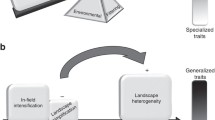Abstract
It has long been recognized that major drivers of biodiversity loss include both the harvest of wild species and the conversion of habitat for productive purposes. Land that is converted may or may not be lost as habitat for many species. In some cases, monoculture production for example, land conversion reduces the number niches and hence the level of biodiversity. In other cases, it has the opposite effect. We address the problem of anthropogenic biodiversity change due to the effects of both harvest rates and land use decisions on landscape heterogeneity. If the optimal structure of the landscape is extremely homogeneous, forces of competitive exclusion will lead to a single surviving species. If it is extremely heterogeneous, multiple species will coexist, with each species exclusively dominating the patch type to which it is best suited. Where changes in biodiversity due to changes in landscape heterogeneity are not taken into account in land use decisions, they are external effects of those decisions. We identify measures of these effects.
Similar content being viewed by others
References
Barbier E, Schulz C (1997) Wildlife, biodiversity and trade. Environ Dev Econ 2(2): 145–172
Brander JA, Taylor MS (1997) International trade and open-access renewable resources: the small open economy case. Can J Econ 30(3): 526–552
Brock WA, Xepapadeas A (2002) Optimal management when species compete for limited resources. J Environ Econ Manag 44(2): 189–220
Conway GR (1993) Sustainable agriculture: the trade-offs with productivity, stability and equitability. In: Barbier EB (eds) Economics and ecology : new frontiers and sustainable development. Chapman and Hall, London, pp 46–65
Crane P, Kinzig A (2005) Nature in the metropolis. Science 308(5726): 1225
Jackson LE, Pascual U, Hodgkin T (2007) Utilizing and conserving agrobiodiversity in agricultural landscapes. Agric Ecosyst Environ 121: 196–210
Kinzig AP, Harte J (2000) Implications of endemics-area relationships in estimates of species extinctions. Ecology 81(12): 3305–3311
Kinzig AP, Levin SA, Dushoff J, Pacala S (1999) Limiting similarity, species packing, and system stability for hierarchical competition-colonization models. Am Nat 153(4): 371–383
Kinzig AP, Ryan P, Etienne M, Elmqvist T, Allison H, Walker BH (2006) Resilience and regime shifts: assessing cascading effects. Ecol Soc 11(1):article 13 (online)
Loreau M, Mouquet N, Gonzalez A (2003) Biodiversity as spatial insurance in heterogeneous landscapes. PNAS 22: 12765–12770
MacArthur RH, Wilson EO (1967) The theory of island biogeography. Princeton University Press, Princeton
May RM, Lawton JH, Stork NE (1995) Assessing extinction rates. In: Lawton JH, May RM (eds) Extinction rates. Oxford University Press, Oxford
McNeely JA, Scherr SJ (2003) Ecoagriculture: strategies to feed the world and save wild biodiversity. Island press, Washington, DC
Millennium Ecosystem Assessment (MA) (2005) Ecosystems and human well-being: synthesis. Island press, Washington, DC
Norberg J, Swaney DP, Dushoff J, Lin J, Casagrandi R, Levin SA (2001) Phenotypic diversity and ecosystem functioning in changing environmentas: a theoretical framework. Proc Nat Acad Sci 98(20): 11376–11381
Pereira HM, Daily GC (2006) Modeling biodiversity dynamics in countryside landscapes. Ecology 87: 1877–1885
Polasky S, Costello C, McAusland C (2004) On trade, land-use and biodiversity. J Environ Econ Manag 48: 911–925
Polasky S, Nelson E, Lonsdorf E, Fackler P, Starfield A (2005) Conserving species in a working landscape: land use with biological and economic objectives. Ecol Appl 15: 1387–1401
Wilcove DS, Rothstein D, Dubow J, Phillips A, Losos E (1998) Quantifying threats to imperilled species in the United States. Bioscience 48: 607–615
Worm B, Barbier EB, Beaumont N, Duffy JE, Folke C, Halpern BS, Jackson JBC, Lotzke HK, Micehli F, Palumbi SR, Sala E, Selkoe KA, Stachowicz JJ, (2006) Impacts of biodiversity loss on ocean ecosystem services. Science 314: 787–790
Author information
Authors and Affiliations
Corresponding author
Rights and permissions
About this article
Cite this article
Brock, W., Kinzig, A. & Perrings, C. Modeling the Economics of Biodiversity and Environmental Heterogeneity. Environ Resource Econ 46, 43–58 (2010). https://doi.org/10.1007/s10640-009-9333-1
Accepted:
Published:
Issue Date:
DOI: https://doi.org/10.1007/s10640-009-9333-1




